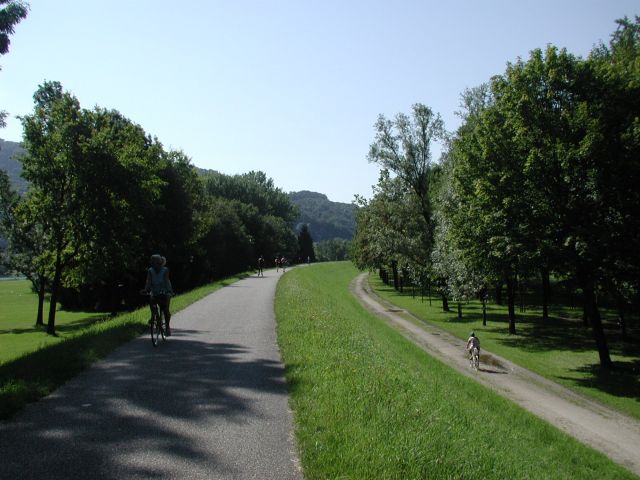
Day 3 -- Linz to Grein
During the night we heard thunderclaps, and the window of my hotel room was lit with flashes of lightning. High on the hill across the river there was a large church with twin steeples. I was thinking that it was a perfect lightning arrestor, as the frequent strobe-like flashes seemed aimed directly at its steeples. But when I awoke in the morning, the world was tranquil, the air fresh, and the sky blue. Once again, fortunately, the forecast of rain appeared to have been wrong. It was ok by me.
We biked back across the big bridge at Linz to the north side of the Danube. A woman was feeding the swans on the far side as we joined a bike path on an elevated mound.

The path east from Linz
On the other side of the mound was a small lake with many sunbathers lying on its shore. It was Sunday morning, the weather was glorious, and the whole world was out. There were many other bikers and rollerbladers. It was probably the most crowded the path was during our trip. We were passed constantly by fast bikers on their road bikes, dressed as if they were in the Tour de France, which was in its second week at that time. Lance had just taken the yellow jersey in the mountains, and all of Europe was watching. Each day after our own bike ride we would turn on the television in the hotel and watch the finishing part of that day's stage. Of course, the commentary was in German, and the name most often mentioned was "Ulrich."
Here's the view I had that morning, looking out over my handlebar bag -- minus my guide book -- at Len biking up in front.
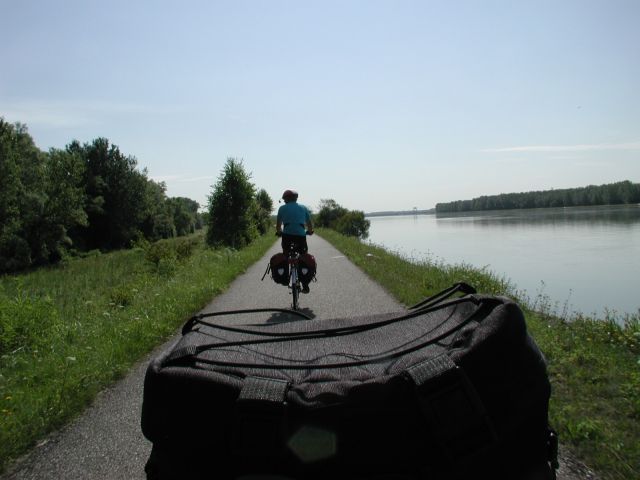
View while biking
After about ten miles of easy biking, we came to a monument to the prisoners killed at Mauthausen, a concentration camp on a hill nearby. The monument focused on a large concrete cylinder suspended by chains, with an explanation of the symbology in both German and English. It was being studied by two Italian women bikers. We joined their silent study for awhile, and then headed off, intending to visit the museum at Mauthausen.
As we passed through a fork in the road, I saw the Italians take the left fork, while we went right. I called for Len to stop and reconsider our direction, assuming that the Italians were going to Mauthausen and had made the correct turn. We retraced and started to bike up a steep, long hill. The guide book warned that the hill was a 14% grade for over a kilometer, which is really quite formidable. I had bad vibes that I was going to bike up this hill only to discover that we were in the wrong place, but it wasn't so. It was a long, hard slog and I had to take several rest stops to catch my breath, but I don't think the hill was actually a 14% grade. Bad, though.
At the top was the concentration camp and a bucolic, panoramic view of the countryside. It was a startling juxtaposition. There were at least four distinct parts of the camp -- the prisoner barracks, a museum, a park full of monuments from the countries whose inmates were killed, and the "death steps" leading down to the quarry where the prisioners were made to work.
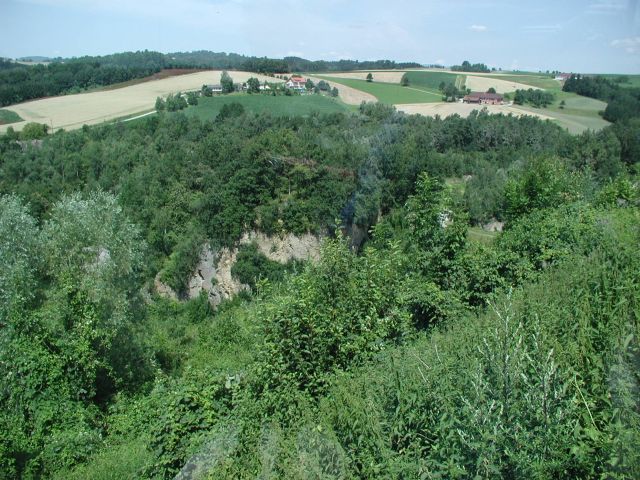
Looking down to the quarry at Mauthausen
Len walked down (and up) the 186 steps of the death stairs, while I waited at the top, recovering from the bike climb. For a while we walked among the monuments representing the countries. Some, if not most, were quite well done. Then we paid the entrance fee to the museum and got an English language tape recorder to guide us through the barracks. There were quite a few visitors, and I think we were the only Americans. The rest appeared to be mostly German and Austrian. Everyone was quiet.
Mauthausen wasn't one of the larger concentration camps. Still, 130,000 people were killed there. About half were Jews, and the rest consisted of Italians, Spainards, Russian POWs, criminals, and political prisoners. I had a hard time staying in some of the rooms, and don't want to write about them here. You had to experience it for yourself.
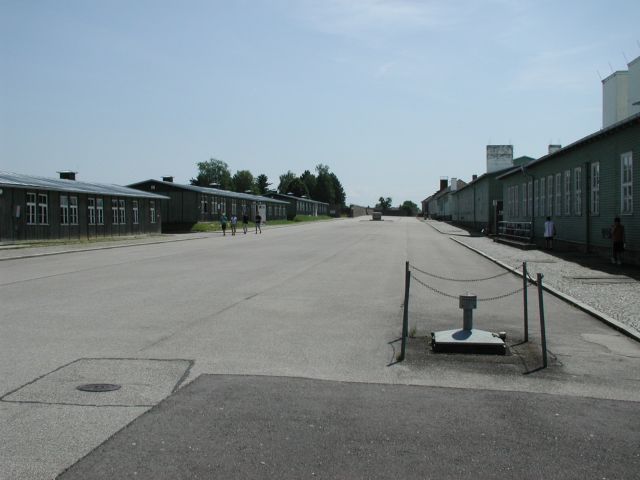
The prisoner barracks at Mauthausen
In the museum the attendant put on a movie in English just for us, and we sat by ourselves in an auditorium watching the history of Mauthausen. Another couple joined us part way through, but that was it. The line from the movie that both Len and I remembered most was a bit of grafiti scribbled on the wall by one of the doomed prisioners. "If there is a God, He will have to beg my forgiveness."
Very much sobered, we coasted down the hill and rejoined the bike path. Slowly our good spirits returned as the path left the river and twisted through farm fields laden with ripening crops.
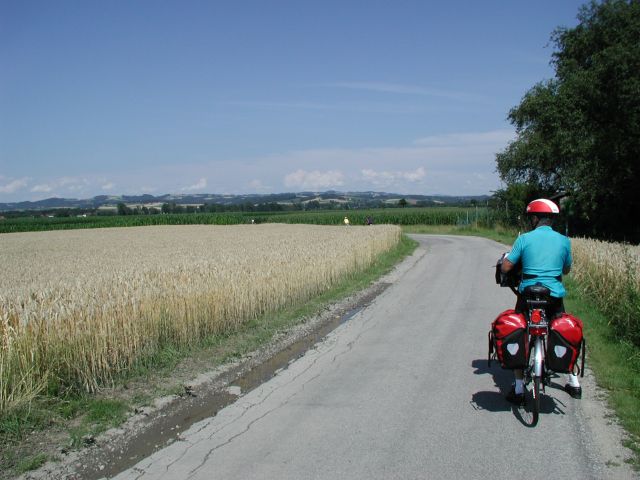
Fields of wheat
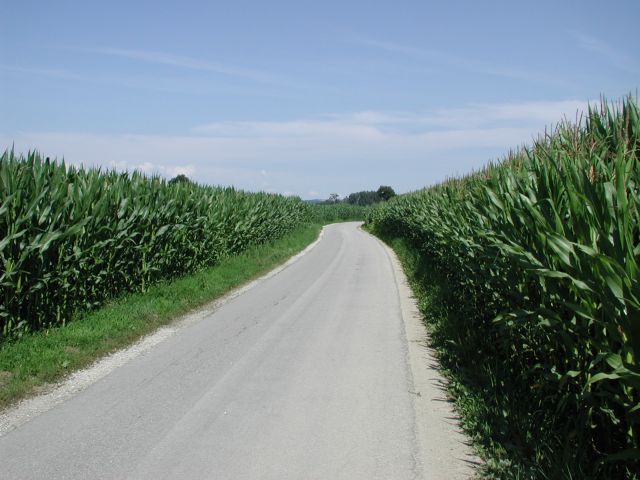
Ripening corn
Everyone told us that the summer had been awful up until this week. There had been constant rain. Between the rain and now the brilliant, warm sunshine, the crops seemed to want to burst into fertility. Len and I several times during the trip had the firm belief that we could see the corn ripening even as we rode by.
It was along here that bad luck struck Len. The display on his new digital camera quit working. It was a Canon digital Elph with a 5 megapixel array -- an expensive and very fine camera. All the display showed was a big purple star on a whitish background. Broken.
I took Len's misfortune almost as badly as he did. You want your biking companion to enjoy the trip, and I know how I would have felt if my camera had broken -- and mine is old and fully depreciated. The big question was: did the camera itself still work? Was it just the display and was it still taking pictures, or was the whole thing non-functional. Of course, there was no way he could use the features in the camera, which all depended on having the display. I suggested that in the town the next morning we go to a camera shop and see if they could pull up the pictures on his memory card.
Len and I have a funny ritual with our cameras. We both take the same pictures. Always. Neither of us can stand the idea that the other would have a picture lacking in our own collection. So, in a real sense, it would be irrelevant if Len's camera didn't work. He could have all my pictures. But I know very well that it's different when you have your own pictures. Silly, but that's the way it is.
Now it was really getting hot, and we had long since emptied our water bottles. Like some kind of mirage in the desert, we saw an "information stand" up ahead on the bike path. Many bikers were milling about, and quite a few were gathered about a fountain flowing cold water. We asked if the water was drinkable, making gestures with our hands towards our mouths. "Yes", they said. Or maybe it was "Ja." In any event it was one of those times when water tasted so very good that even now in my memory I feel it going down my throat.
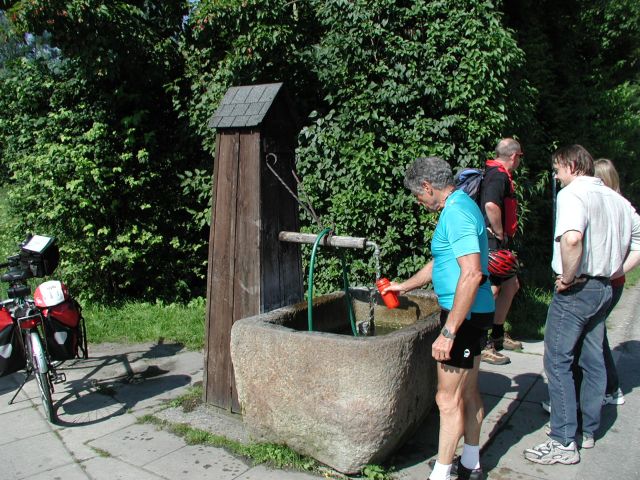
Filling our water bottles at an information stand on the bike path
We also passed by quite a few field of sunflowers. I constantly marveled at how they could follow the sun.
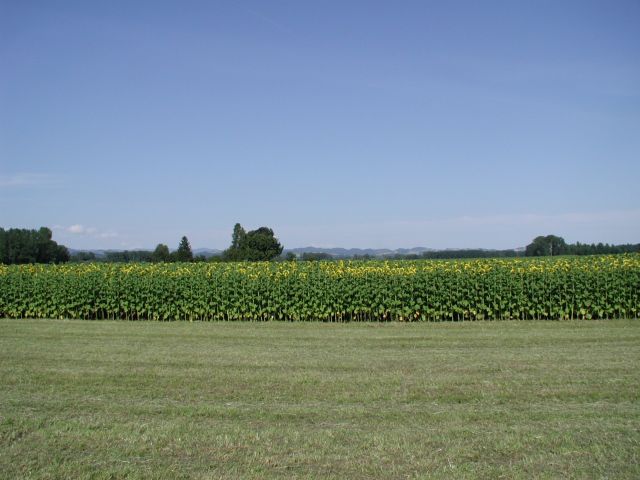
Fields of sunflowers
It was late in the afternoon when we approached the little town of Grein, our destination for that day.
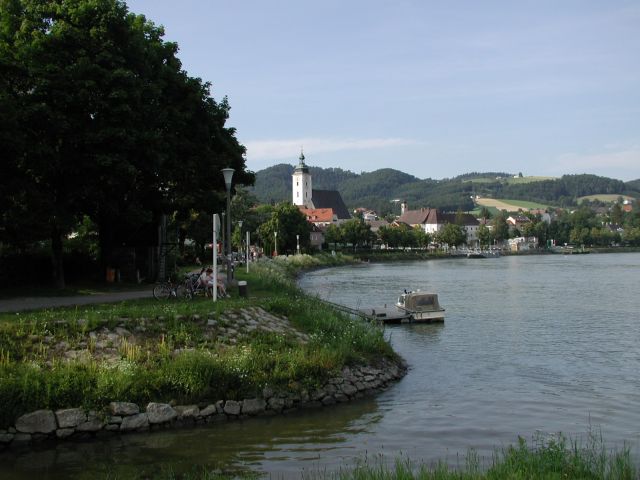
The town of Grein appears ahead
Once again we pulled out the instruction about how to find our hotel, the Goldenes Kreuz. We were supposed to bike down a certain road, find a square, and make some turn. While we were reading this, Len looked up, and there was the hotel right above us. I can't recall an instance when those hotel-finding instructions were ever helpful. We had traveled 42.2 miles, and with spending three hours in Mauthausen it had been a long day.
Grein was essentially a one-square town, but a very friendly and pretty town. Here's the square.
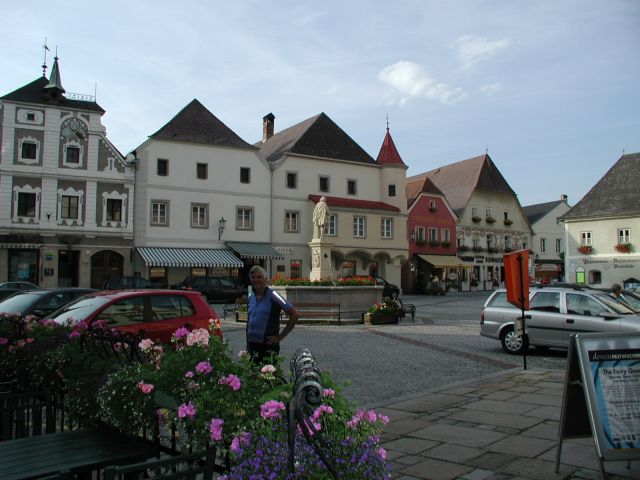
The town square in Grein
A sign said that there would be a band concert in the square at 7:00pm. We waited, sitting on the bench in front of the fountain, as the band assembled.
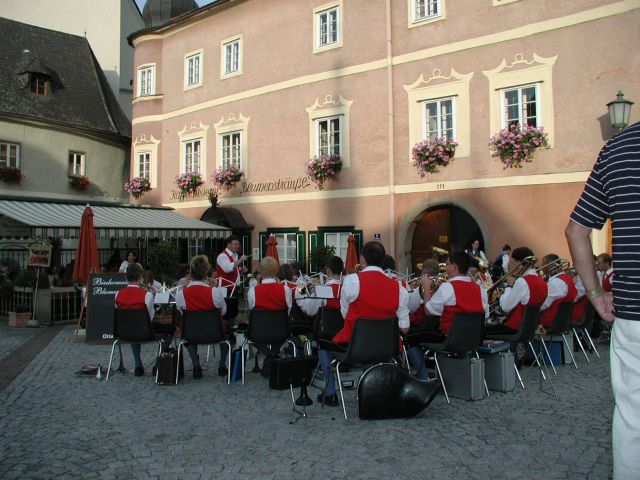
Sunday night band concert in the square in Grein
I thought that this would be real atmosphere. Grein wasn't a tourist town, and these were all locals gathered for the concert. However, I was disappointed. Instead of playing German band songs, they played bits of a symphony and some American songs. Everything sounded the same, and it was all lifeless. I've heard better music in an elevator, I'm sorry to say.
So we had dinner on the porch of a restaurant on a far corner of the square. We could hear the band, but it was pretty well muted where we were. Afterwards, we got some delicious ice cream cones and strolled down along the Danube. It was a warm night and the little town was alive.
Proceed to Day 4 of the Danube trip
Back to the Danube overview page